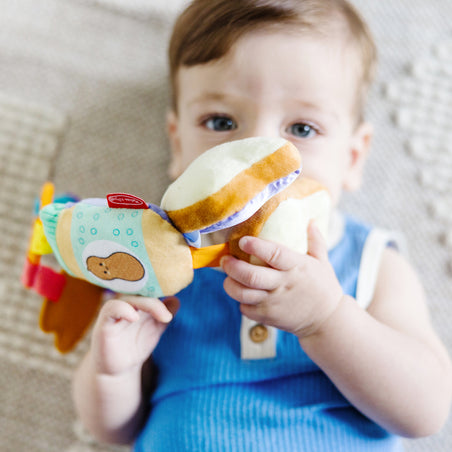Babies are more brilliant than any artificial intelligence program a tech company can develop. Why? Because they are taking in so much information, through so many channels, and constantly working to blend that information with what they already know. They take the world in by playing with it and exploring it.
Infants are in what we consider a sensorimotor stage of play. This is all about taking in information with their senses, moving around rooms, and grabbing and manipulating objects. They are mastering being a part of the 3-D world and mapping it in their brains. It’s pretty cool. Soon, once they are a toddler, they will get to symbolic play (vrooming a car around, using a hammer to bang on things), then pretend play (pretending to be a lion or to sweep the floor), and then imaginative play (leading a classroom of stuffed animals!).
So how can you set the stage for a brain that will love the playfulness and expansiveness of imagination, even when an infant is just gurgling at you or banging two blocks together?

-
Build a flexible attention span.
When babies look at the same thing over and over, they don’t get as much of a chance to build mental categories or see all the various ways the world works. So limit TV, videos, and YouTube for babies and instead direct their attention to the objects and activities around them. Infants will look at what their caregivers are paying attention to, so try showing them new things and talking about whatever they seem to be looking at. It may sound basic, but if you can’t focus and shift your attention, it’s hard to play pretend! -
Break out of play ruts.
When you are playing with your baby, and they seem to be doing the same thing over and over again, change it up just slightly. If they are banging a pan with their hand, give them a wooden spoon to bang with. If they are putting blocks in a bucket, try making zooming or silly noises as the blocks fall in. Think of it like a “variation on a theme” in classical music — where the basic play pattern is the same, you just change it up a bit. -
Make stuffies talk and think.
When my kids were infants, we had a different voice for every single stuffed animal or puppet in their room. My kids would interact with them like they were alive at first, and eventually they would start pretending with them too — that they were going to the doctor or they had certain feelings about going to bed! These are some of babies’ and toddlers’ magical relationships, and are one of the easier ways kids think imaginatively.
Also, it’s not too early to start reading books to infants. They love the rising and falling sounds of our voices, and it’s a snuggly way to help them learn to sit calmly and pay attention — even if it’s only for a few minutes at a time — without a dang screen! I still read to my 9-year-old some nights, and it calms us both down. Hopefully you have something similar that gives you those calm moments with your littles.










